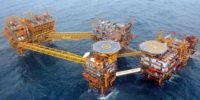Ras Bufontas Free Zone
Doha, Qatar
BEST PROJECT
OWNER: Qatar Free Zones Authority
OWNER REPRESENTATIVE: Economic Zones Co.
LEAD DESIGN FIRM: AECOM
LEAD CONTRACTOR: SACYR Construction S.A. URBACON Trading & Contracting JV
CONSULTANTS: Dorsch Qatar; D.G. Jones
SUBCONTRACTORS: ERITBAT; Qatar Power; United Technical Services; Gulf House; CYTECO Engineering; Storm Construction; Al Dawish; Unigulf/Al Jaber
This 4-sq-mile trade hub for local and international companies was designed and built to meet strict guidelines under the Global Sustainability Assessment System, which rates building and infrastructure sustainability impacts and assesses how well local needs and environmental conditions specific to the Middle East and North Africa are addressed.
Jassem Said, a spokesman for the project owner, Qatar Free Zones Authority, describes the Ras Bufontas Free Zone in the team submission as “smart, sustainable, green and investor-oriented.”
The trade hub includes a Business Innovation Park (below) with a built-up area of 35,000 sq meters.

Trade hub includes a Business Innovation Park with four wings connected by a pedestrian bridge that surround an internal courtyard with a built-up area of 35,000 sq meters. Photo: Qatar Free Zones Authority
Key trade zone sustainablity features include water-sensitive landscaping and use of treated sewage effluent. A drip irrigation system is designed to reduce water usage by up to 70% compared with methods such as sprays and sprinklers. The hub’s solid waste management system will recycle half of all waste generated and compost 29% of it. The waste will be processed for offsite treatment to divert it from landfills.
The Ras Bufontas facility also includes measures to preserve the environment near the hub and protect its biodiversity, including a 200-m-wide coastal protection buffer and public transport alternatives to reduce the need for private vehicles. Facility carbon emissions are set to be 50% lower than conventional developments of a similar scale. The hub is adjacent to Hamad International Airport and directly connected to the first line of the Doha Metro, which opened in 2019.

International and local business hub in Doha, Qatar, meets strict sustainability guidelines designed for the region’s climate.
Photo: Qatar Free Zones Authority
Despite a transportation blockade by neighboring countries that began in 2017 and ended in January affecfing the import of construction products for the project, the team says it specified alternative materials or found other sources for approved items, enabling it to finish on time and on budget. To maintain safety, the team says every engineer and worker joined regular toolbox meetings and received “a safety induction” before starting any onsite work.
Ras Bufontas Free Zone is intended for companies in such sectors as logistics, technology, consumer products, light manufacturing and pharmaceuticals. The trade hub “has been designed to allow investors to take full advantage of ... technologies such as 5G, the internet of things and expansion of AI-based services,” says Jassem.






Post a comment to this article
Report Abusive Comment